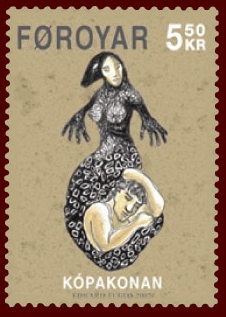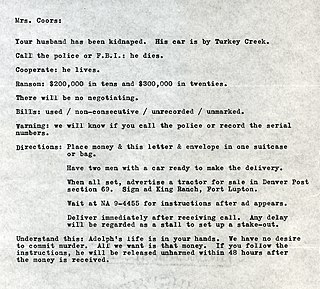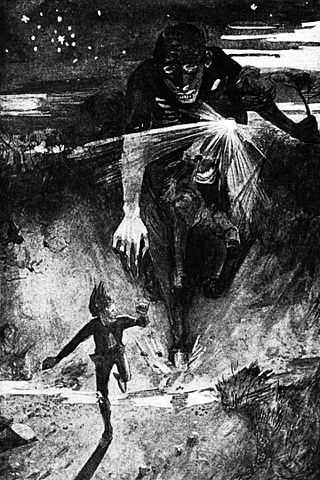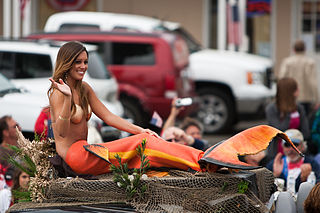Related Research Articles

Rousay is a small, hilly island about 3 km (1.9 mi) north of Mainland, the largest island in the Orkney Islands of Scotland. It has been nicknamed "Egypt of the north", due to its archaeological diversity and importance.

A fairy is a type of mythical being or legendary creature, generally described as anthropomorphic, found in the folklore of multiple European cultures, a form of spirit, often with metaphysical, supernatural, or preternatural qualities.

In folklore, a mermaid is an aquatic creature with the head and upper body of a female human and the tail of a fish. Mermaids appear in the folklore of many cultures worldwide, including Europe, Asia, and Africa.
A trow is a malignant or mischievous fairy or spirit in the folkloric traditions of the Orkney and Shetland islands. Trows may be regarded as monstrous giants at times, or quite the opposite, short-statured fairies dressed in grey.

A changeling, also historically referred to as an auf or oaf, is a human-like creature found throughout much of European folklore. A changeling was a substitute left by a supernatural being on kidnapping a human being. Sometimes the changeling was a 'stock', more often the changeling was a supernatural being made magically to look like the kidnapped human. Supernatural beings blamed for stealing children included fairies, demons, trolls, nereids and many others. Usually, the kidnapped human was a child; but there were cases, particularly in Scandinavia and Ireland, where adults were taken.

The Northern Isles are a chain of islands off the north coast of mainland Scotland. The climate is cool and temperate and highly influenced by the surrounding seas. There are two main island groups: Shetland and Orkney. There are a total of 36 inhabited islands, with the fertile agricultural islands of Orkney contrasting with the more rugged Shetland islands to the north, where the economy is more dependent on fishing and the oil wealth of the surrounding seas. Both archipelagos have a developing renewable energy industry. They share a common Pictish and Norse history, and were part of the Kingdom of Norway before being absorbed into the Kingdom of Scotland in the 15th century. The islands played a significant naval role during the world wars of the 20th century.

Selkies are mythological creatures that can shapeshift between seal and human forms by removing or putting on their seal skin. They feature prominently in the oral traditions and mythology of various cultures, especially those of Celtic and Norse origin. The term “selkie” derives from the Scots word for “seal”, and is also spelled as silkies, sylkies, or selchies. Selkies are sometimes referred to as selkie folk, meaning 'seal folk'. Selkies are mainly associated with the Northern Isles of Scotland, where they are said to live as seals in the sea but shed their skin to become human on land.

Bride kidnapping, also known as marriage by abduction or marriage by capture, is a practice in which a man abducts and rapes the woman he wishes to marry.

The nuckelavee or nuckalavee is a horse-like demon from Orcadian folklore that combines equine and human elements. British folklorist Katharine Briggs called it "the nastiest" of all the demons of Scotland's Northern Isles. The nuckelavee's breath was thought to wilt crops and sicken livestock, and the creature was held responsible for droughts and epidemics on land despite being predominantly a sea-dweller.

Evie is a parish and village on Mainland, Orkney, Scotland. The parish is located in the north-west of the Mainland, between Birsay and Rendall, forming the coastline opposite the isle of Rousay.

Mermaids, like many other creatures of mythology and folklore, are regularly depicted in literature, film, music, and popular culture. In the folklore of some modern cultures, the concept of the siren has been assimilated to that of the mermaid. For example, the French word for mermaid is sirène, Italian sirena, and similarly in certain other European languages. This usage existed by the Middle Ages.

SuvannamacchaRTGS: Suphannamatcha or Suphan Matcha;ALA-LC: Suvaṇṇmacchā; Pali: सुवण्णमच्छा, suvaṇṇamacchā; literally "golden fish") is a daughter of Ravana (Thotsakan) appearing in the Thai and other Southeast Asian versions of Ramayana. She is a mermaid princess who tries to spoil Hanuman's plans to build a bridge to Lanka but falls in love with him instead.
Mythic humanoids are legendary, folkloric, or mythological creatures that are part human, or that resemble humans through appearance or character. Each culture has different mythical creatures that come from many different origins, and many of these creatures are humanoids. They are often able to talk and in many stories they guide the hero on their journey.
A nuggle, njuggle, or neugle, is a mythical water horse of primarily Shetland folklore where it is also referred to as a shoepultie or shoopiltee on some parts of the islands. A nocturnal creature that is always of a male gender, there are occasional fleeting mentions of him connected with the Orkney islands but he is more frequently associated with the rivers, streams and lochs of Shetland. He is easily recognised by his distinctive wheel-like tail and, unlike his evil counterparts the each-uisge or the nuckelavee, has a fairly gentle disposition being more prone to playing pranks and making mischief rather than having malicious intents.
The Sirena is a mythological sea creature from Filipino culture. In some regions of the Philippines, particularly Bicol and Visayas, Sirenas are known as Magindara and portrayed as vicious mermaids. Like Sirens of Greek mythology, they have alluring and irresistible singing voices; unlike Sirens, who are portrayed as part woman and part bird, Sirenas are often described as mermaid-like creatures living under the sea. In Philippine mythology, the Sirena is a mythological aquatic creature with the head and torso of a human female and the tail of a fish. The Sirena is an Engkanto –' the Filipino counterpart of English mermaids. Engkantos are classified as one of the Bantay Tubig, a Filipino term for mythical guardians of the water. In addition to the Sirena, other examples of Bantay Tubig are Siyokoy, Kataw, and Ugkoy. The male version of a Sirena is called a Sireno. Sometimes, Sirena are paired with Siyokoy. A popular mermaid character in the Philippines is Dyesebel.

Giantesses are imaginary, gigantic women. They are widely believed to be mythological by the humans of modern-day, since the term "giantess" is so generic, it seems possible to describe female giants not native to Earth which fall under the very forgiving criteria as giantesses. This includes the female giant: either a mythical being, such as the Amazons of Greek mythology, resembling a woman of superhuman size and strength or a human woman of exceptional stature, often the result of some medical or genetic abnormality.
A water spirit is a kind of supernatural being found in the folklore of many cultures:

Eynhallow Church is a ruined medieval church located on the uninhabited island of Eynhallow in Orkney, Scotland. The church dates back to the 12th-century and is thought to have originally been a monastery. Near the church are the building remains from a post-medieval village. Historic Environment Scotland first listed the site as a scheduled monument in 1921.
The Yacuruna are a mythical water people of the Amazon basin who live in beautiful underwater cities, often at the mouths of rivers. Belief in the Yacuruna is most prominently found among indigenous people of the Amazon. The term is derived from the Quechua language, yaku ("water") and runa ("man").
References
- ↑ "Johnny Croy and his Mermaid Bride". Orkneyjar. Retrieved 2014-03-13.
- ↑ "Finfolkaheem, The Ancestral home of the Finfolk". Orkneyjar. Retrieved 2014-03-13.
- ↑ "Hildaland, the Summer home of the Finfolk". Orkneyjar. Retrieved 2014-03-13.
- 1 2 "The Freeing of Eynhallow". Orkneyjar. Retrieved 2014-03-13.
- ↑ "The Eynhallow Riddle". Orkneyjar. 1990-07-14. Retrieved 2014-03-13.
- ↑ "The Mermaid Daughter of the Finfolk". Orkneyjar. Retrieved 2014-03-13.